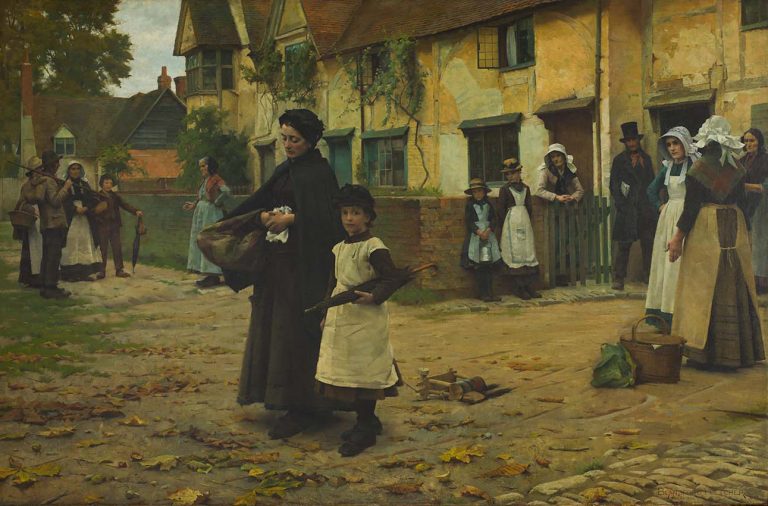We acknowledge the Traditional Owners of the land on which the Queensland Art Gallery | Gallery of Modern Art stands and recognise the creative contribution First Australians make to the art and culture of this country.

Blandford Fletcher / England 1858–1936 / Evicted 1887 / Oil on canvas / Purchased 1896 / Collection: Queensland Art Gallery | Gallery of Modern Art
Blandford FletcherEvicted 1887
Not Currently on Display
Evicted 1887 was the first purchase of the newly founded Queensland Art Gallery in 1895. It was painted at a time when pictures were often painted to tell a story. Evicted could be ‘read’ almost like a scene from a Victorian novel; it depicts a widow and her young daughter being forced from their home, a popular subject for many artists of the period.
The curious and sympathetic crowd watch the pair walk away after the top-hatted bailiff has carried out his onerous task. Set in the Berkshire village of Steventon in England, the traditional lime-washed houses, dating from the sixteenth century, still stand today.
The almost photographic representation, the near life-size figures and the wide view of the village street convey a sense of reality. Despite their difficult circumstances, Blandford Fletcher has portrayed the central figures with a sense of dignity, rendering them sympathetic to the viewer.
Blandford Fletcher was born in London in 1858 and began his art training in South Kensington. Later he went to Antwerp, Belgium, where he studied at the Royal Academy of Arts. Fletcher also travelled regularly to France, where he was introduced to painting en plein air and met the French painter Jules Bastien-Lepage.
The romanticised realism of Bastien-Lepage’s rural scenes had a strong influence on Fletcher, who adapted this style to a British context and often depicted the poor and disadvantaged. Fletcher was associated with the Newlyn School in Cornwall, England, and exhibited at the Royal Academy from 1884.
Discussion Questions
1. What does the word ‘evicted’ mean? Why do you think this mother and child have been evicted?
2. Consider what effect the direct outward gaze of the young girl has on your experience when viewing the work. Discuss this in terms of emotional responses and how the outward gaze influences the composition.
Classroom Activities
1. Compare and contrast modern day homelessness with that of nineteenth-century Britain. If you could assist, how might you help? On an A3 piece of paper, draw the contents of a care package for this family. Include items that would have been relevant for this historical time and place.
2. Research the plight of those displaced. Choose one of these social challenges and develop ideas for an artwork which makes a pertinent social and emotional comment. You could use narrative realism (like Fletcher’s Evicted), or abstracted and symbolic references giving clues to your chosen context.